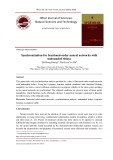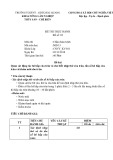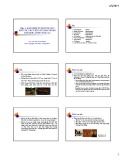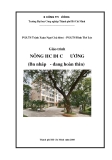
Vietnam Journal
of Agricultural
Sciences
ISSN 2588-1299
VJAS 2024; 7(4): 2327-2341
https://doi.org/10.31817/vjas.2024.7.4.07
https://vjas.vnua.edu.vn/
2327
Received: September 4, 2023
Accepted: December 16, 2024
Correspondence to
vuhaike@vnua.edu.vn
Internal Control System in Cooperatives:
A Systematic Review
Vu Thi Hai*, Tran Quang Trung & Bui Thi Mai Linh
Faculty of Accounting and Business Management, Vietnam National University of
Agriculture, Hanoi 12400, Vietnam
Abstract
Internal control plays an essential role in improving the efficiency
of resources and ensuring the achievement of organizational goals.
This study aimed to systematically synthesize articles published in
Vietnam and abroad on the topic of “internal control” and “internal
control system” in cooperatives during the period of 2012-2023.
The conceptual framework of internal control, research methods,
and main results of publications were summarized. The findings
showed that empirical studies on internal control have frequently
been conducted in financial and credit organizations, however, there
are limited studies in the cooperative model. The publications
focused on three main contents, namely the status and structure of
internal control in organizations; the roles and impacts of internal
control on performance and corporative governance; and the factors
affecting the effectiveness and efficiency of internal control. The
COSO framework has been applied by most authors in analyzing
the current situation of internal control and internal control systems.
The positive impacts of internal control on efficiency (ROA and
ROE) and the sustainability of cooperatives were confirmed by the
authors. Limitations in human resources, scale, technology, and
staff awareness of internal control were considered as barriers to
implementation of internal control in organizations.
Keywords
Internal control, internal control system, cooperatives
Introduction
Internal control (IC) plays an essential role in monitoring an
organization’s activities (Tran et al., 2021), especially in the context
of a changing technology environment, the increasing complexity of
business transactions, and the limitations and weaknesses of internal
management that often lead to a rise of risks in organizations.
According to the Committee of Sponsoring Organizations (COSO,
2013), IC is a process performed by the board of directors, or other
individuals in an entity, and is designed to provide reasonable
assurance to the organization, in order to achieve their objectives of

Internal control system in cooperatives: A systematic review
2328
Vietnam Journal of Agricultural Sciences
effective and efficient activities; financial
statement reliability and regulations
compliance; risk reduction; and achievement of
organization goals. An effective internal control
system (ICS) would support and monitor
performance effectively, enhance regulations
compliance, ensure capital management
efficiency (Ha My Trang et al., 2022), reduce
the organization’s loss risk, reduce frauds and
asset losses (Ha & Dung, 2018; Long et al.,
2022), and maintain continuous operation.
A cooperative is a collective economic
model that is voluntarily established by members
with common interests, who cooperate and
support each other in doing business, in order to
boost operational efficiency and meet the
common needs of members. It is based on
autonomy, self-responsibility, equality, and
democracy in management and control
(Government, 2012). In Vietnam, cooperatives
have become an indispensable component of the
economy that contribute to the economic growth
(Garnevska et al., 2014), especially in
agricultural and rural areas, and they have a
particularly important role in achieving the goals
of sustainable growth, rural construction, poverty
reduction, and environment improvement.
Effective cooperatives bring benefits to
members, such as transaction cost reductions,
product quality management improvement,
market access enhancement, supportive policies
access, training and technical support, and
stable/competitive prices for purchasing and
selling activities, which then raise the members’
income. Cooperatives also set their own
missions and goals as other business types.
Instead of maximizing profits, cooperatives aim
to maximize benefits for members and the
community, and improve the members'
capacity. There are, however, always barriers
that prevent cooperatives from achieving their
goals. For instance, disagreements within the
cooperatives, the capacity weaknesses of
managers and employees, the limitations of
financial resources, or the shortage of
knowledge and skills in the market and
technology access (Bretos & Marcuello, 2017)
are the weak points of the cooperative model.
IC in general has been considered as an
effective tool for managers and enables
organizations to prevent, detect, and promptly
correct errors, limit damage, and attain their
goals. Especially in the field of cooperatives, IC
has been seen as one of the significant factors in
managing and operating cooperatives
effectively (Kiyieka & Muturi, 2018).
Cooperatives perform the role of supporting,
inspecting, and monitoring members' production
processes to ensure that they comply with and
meet the required standards, which then reduce
risks in the production processes (Bharaditya et
al., 2017). Thereby, members could be able to
obtain certificates in accordance with registered
processes, which would lead to an increase in
product consumption. Research has
demonstrated that there is a positive relationship
between IC and an organization’s performance
(Kule et al., 2022; Ouko & Atheru, 2022),
including agricultural enterprises (Shabri et al.,
2016). By contrast, ineffective IC could create
great risks for an organization, including
cooperatives (Bharaditya et al., 2017; Rahim et
al., 2017; Utaminingsih et al., 2020).
Briefly, the role of IC is undeniable for the
operation of cooperatives in general and
agricultural cooperatives in particular. However,
research in this field is still very limited. This
article aimed to systematically synthesize
related research in terms of IC in cooperatives
around the world as well as in Vietnam, thereby
aiming to identify the main research directions
and research gaps of this topic.
Methodology
This work leveraged articles from
ScienceDirect, Google Scholar, and NASATI (a
Vietnamese database) to explore the field of IC
systems within cooperatives. Keywords related
to IC systems and their application in economic
organizations, including cooperatives and
enterprises, guided the search and article
download process. The search was set to include
recent publications from 2012 to 2023 to
capture current ideas and developments on IC
systems in economic organizations, particularly
in cooperatives in Vietnam. For selecting
specific articles for review, the Preferred

Vu Thi Hai et al. (2024)
https://vjas.vnua.edu.vn/
2329
Reporting Items for Systematic Reviews and
Meta-Analyses (PRISMA) framework was used
to ensure transparency and provide a systematic
approach for selecting high-quality publications.
In total, 591 Vietnamese articles and 358
international articles (949 articles altogether)
were retrieved, covering cases of IC systems in
various economic organizations. Since there
were limited results specifically for IC systems
in Vietnamese cooperatives, articles were also
gathered on IC system applications in other
countries and other economic organizations,
including enterprises. All 949 articles were
downloaded for further review.
The selection process is detailed in Figure
1. After removing 727 duplicates, an additional
115 records were excluded during screening,
and 20 more were removed at the final selection
stage, resulting in a total of 85 articles included
in the review. These articles were classified
based on their focus on ICs within industry,
economic organizations, and other relevant
contexts in both Vietnam and internationally.
Results
Overview of research on internal control in
Vietnam
Studies on IC and ICS have been carried out
by several authors in Vietnam in the fields of
banking and insurance (Nguyen Tuan, 2016;
Hung & Tuan, 2019; Hoang Thi Huyen, 2020;
Quoc Trung, 2021; Nguyen Thi Cuc Hong,
2021; Nguyen Thi Quynh Huong, 2021);
construction (Hoang Thi Hong Le et al.,
2022;Tri et al., 2020; Vu et al., 2020); garment
and agriculture (Nguyen Thi Bich Thuy &
Nguyen Thi Khanh Phuong, 2012; Nguyen Thi
Phuong Lan & Le Thi Lan Huong, 2013; Do
Huy Thuong & Nguyen Thi Phuong Hong, 2020;
Figure 1
. PRISMA flow diagram showing the selection of articles for this review work
Records removed as duplicates: 453
Vietnamese articles and 274 International
articles (n=727)
Records screened: 138 Vietnamese articles
and 84 International articles (n=222)
Full-text articles
excluded:12 Vietnamese
articles and 8 International
articles (n=20)
Full-text articles assessed for eligibility: 65
Vietnamese articles and 42 International
articles (n=107)
Studies included in the review and qualitative
synthesis: 53 Vietnamese articles and 34
International articles (n=85)
Records excluded: 73
Vietnamese articles and
42 International articles
(n=115)
Records identified through database searches:
591 Vietnamese articles and 358 International
articles (n=949)
Identification
Screening
Eligibility
Included

Internal control system in cooperatives: A systematic review
2330
Vietnam Journal of Agricultural Sciences
Trinh Le Tan & Dao Thi Dai Trang, 2020;
Tran Trung Tuan & Tran Thi Song Lam,
2021); wood-working (Tran Thi Quanh & Le
Mong Huyen, 2017); and other fields (Pham
Duc Binh, 2013; Anh et al., 2020; Thuan,
2020; Nguyen Thi Que et al., 2021; Nguyen,
2021; Le Quoc Hoi et al., 2022); and in the
model of corporations and listed companies
(Nguyen Thi Phuong Hoa & Nguyen To Tam,
2013; Nguyen Thi Que et al., 2021),
enterprises in general (Nguyen Thi Phuong Lan
& Le Thi Lan Huong, 2012; Le Thi Lan Huong
& Nguyen Thi Phuong Lan, 2018; Ha & Dung,
2018; Do Vu Phuong Anh, 2022); small and
medium-sized enterprises (Nguyen Hoang Son
et al., 2020; Thuan, 2020; Le Quoc Hoi et al.,
2022), and also in universities, public
organizations, and other unit models (Dinh The
Hung et al., 2013; Nguyen Huu Tan & Tran
Dinh Khoi Nguyen, 2020).
Most of the studies (nearly 80%)
approached IC based on the COSO model with
five factors, namely control environment (CE),
risk assessment (RA), control activities (CA),
information and communication (CI), and
monitoring. According to the COSO's
theoretical framework (1992, 2013) with five
elements and 17 principles, researchers have
developed scales to evaluate IC in accordance
with organizational characteristics, industries,
and organizations.
Published research has focused on three
main areas of IC in enterprises and
organizations, namely:
(1) Research on the general situation of IC
in organizations
With the model of state-owned enterprises,
IC is mainly carried out by a supervisory
board. It is still formal, however, it is also
inefficient, not focused on IC activities, and the
controllers lack the authority, conditions,
criteria, and standards to implement financial
and operational control (Tran Viet Lam, 2012).
In his research, Tran Viet Lam (2012) said that
the COSO model with five components has
been considered as theoretical guidelines for
building and perfecting the ICS for state-
owned enterprises. In this specific business
type, it is essential to create a CE for all
members to identify their roles and
responsibilities and participate in IC activities.
In the RA component, firstly, it is necessary to
identify the objectives of the enterprise. There
are normally three groups of objectives,
namely operational, financial reports, and
compliance goals, from which to identify and
evaluate possible risks that threaten the
achievement of goals. In addition, with
monitoring components, to effectively evaluate
and monitor the ICS, there should be
coordination between IC and external control
by agencies such as the Government
Inspectorate and the State Audit.
Using the descriptive statistics method,
based on the COSO approach, authors Nguyen
Thi Le Ha & Tran Thi Anh (2018) and Trinh Le
Tan & Dao Thi Dai Trang (2020) described the
current situation of IC of surveyed businesses,
detailed in specific factors. Surveying 336 small
and medium-sized enterprises in Thai Nguyen,
Nguyen Thi Le Ha & Tran Thi Anh (2018)
illustrated that the CA were evaluated well,
while the four remaining elements were
assessed at an average level. With this type of
business, due to limitations in scale and
resources, the components of IC might not be
clearly identified, however all the elements
would still be implemented (Pham Thanh Thuy,
2019). The authors believed that to build an
effective ICS in this business type,
organizations should focus on improving the
quality of human resources and regular IC
monitoring. Dinh The Hung et al. (2013)
demonstrated that CE, RA, the accounting
information system, control procedures, and
monitoring were the basic necessary elements of
ICS of universities. In the case of the CE
component, the main factors were from both
outside and inside an organization, namely
management philosophy, leadership style,
employee capacity, organizational structure,
personnel policies, government and industry
policies, and regulations that universities must
comply with.
(2) Research on the impact/relationship
between IC and performance and information
quality

Vu Thi Hai et al. (2024)
https://vjas.vnua.edu.vn/
2331
Table 1. Classification of published articles on ICS in Vietnam
Criteria
No. of Papers
Frequency (%)
By Industry
53
Manufacturing (wood, textiles, agriculture, rubber, etc.)
15
28.3
Commerce/trade
1
1.9
Services (banking, credit)
11
20.8
Other (education, media, tax)
6
11.3
None*
20
37.7
By type, organization
53
Listed companies
4
7.5
Government
1
1.9
Small and medium
8
15.1
Bank
11
20.8
General enterprises
23
43.4
Other
6
11.3
By ICS approach framework
53
COSO
39
73.6
COSO, Basel
3
5.7
Other
11
20.8
By main content
53
Situation of IC (ICS) in organizations
9
17.0
The role and impact of IC (ICS) on an organization’s performance
17
34.0
Factors affecting ICS, effectiveness of IC (ICS)
26
49.1
Note: * No industry mentioned.
Quantitative methods, exploratory factor
analysis (EFA), and regression analysis were
applied to evaluate the impact of IC in general
and each element in the ICS on an
organization’s performance. The IC was based
on the five elements of the COSO model, while
the organization’s performance was measured
by the ROA indicator (Nguyen Thi Kim Anh &
Nguyen Thi Phuong Hoa, 2018; Hoang Thi
Huyen, 2020), and the ROE indicator was used
to calculate financial efficiency (Nguyen Thi
Que et al., 2021). The results confirmed the
positive relationship between the quality of IC,
the elements of IC, and the organization’s
performance. Nguyen (2021) affirmed that
monitoring and CI were the two factors that had
the strongest impacts on the efficiency of
pharmaceutical companies. IC and the ICS’s
elements had positive influences on the
performance efficiency of nearly 500 surveyed
forestry enterprises (Nguyen Thi Kim Anh &
Nguyen Thi Phuong Hoa, 2018) and surveyed
garment and agricultural enterprises (Do Huy
Thuong & Nguyen Thi Phuong Hong, 2020),
and significantly affected the financial
efficiency of listed companies and construction
enterprises (Nguyen Thi Que et al., 2021;
Hoang Thi Hong Le et al., 2022; Tran Thi
Khanh Linh et al., 2023).
It has been suggested that control aims at
helping organizations supervise and manage
risks and ensure the quality of financial
statements. Therefore, a number of research has
been carried out to evaluate the impacts of the
ICS’s components on risk control quality
(Nguyen Thi Phuong Lan & Le Thi Lan Huong,
2013; Hoang Thi Huyen, 2020), or the effects of
IC on the quality of financial statement
information (Nguyen Thi Phuong Hoa &
Nguyen To Tam, 2013; Nguyen Anh Hien,
2019; Pham Thanh Thuy, 2019; Thuan, 2020).
Studies have shown that there is a positive


























